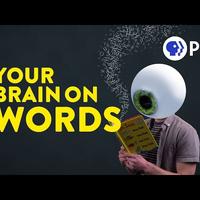How Do We Read? It's Magic (Almost) (2)
And beyond that is an even blurrier zone. No letters being identified here, but importantly
you are sensing how long the next word or two is.
This gives you enough information to decide where your eyes will move next. If the next
word is short and can be skipped, or whether it's long and unfamiliar so you should stop on it.
While you are recognizing the word you are actually looking at and focusing on,
another part of your eye is already reading ahead to tell you what's coming next.
All in all your eyes only stop on about 60% of the words you read. Yet
somehow you still read all of them.
AND YOU HAVE NO IDEA YOU'RE DOING THIS.
So we seem to recognize words not because of their shape, but because of the letters they contain.
Which maybe isn't that surprising,
except we're seeing most of those letters without actually looking at them.
We think the way we recognize words works something like this:
When your eyes land on or near a word, say SOAP,
you see ALL the letters, that is, you process their shapes - basically simultaneously.
You don't scan the letters from left to right one by one,
as if your brain is looking up a word in a dictionary.
You know, the first letter "s" the second letter "o" . . . it doesn't work that way.
Your brain simultaneously compares
each letter position with those in all the words you've seen before.
Think of your mental dictionary as a pool full of words. Every word with one letter
in common gets a little jolt in your brain's neural networks and floats above the rest.
The words with two letters in common get a bigger jolt in your brain and rise above those.
Then the words with three letters in common get an even bigger jolt.
Until finally, the strongest signal in the neural network of your brain's dictionary
rises to the top, and that's the winner: The word you recognize.
This happens over and over as your eyes jump from spot to spot across the page,
taking in different kinds of information from various parts of your eye, unconsciously reading
ahead in your brain, activating countless neural networks, all in less than a quarter of a second.
And then you move your eyes, and do it again, and again, and again. All thanks to some ancient
evolutionary ability you have to recognize certain shapes, curves, and corners.
And the coolest part of all this is the next time you pick up a book,
you won't even think about any of this. You'll just
enjoy a good story. As long as the I's and the O's are the right size at least…
Stay curious.
And as always, a huge thank you to everyone who supports the show on Patreon.
You guys know how Patreon works. Thank you so much for your support.
That is really what helps us make these videos, keep this channel going, support our team, and,
we couldn't do it without you. If you would like to help us do all of this, there is a link
down in the description where you can learn more. And I will see you in the next video.
Hey guys, if you liked this video, then you are going to love the show “Otherwords”
It's over on PBS Storied. You can click the link right up there to check it out. It's a
show all about language and linguistics and the stories inside of that from around the world
that we all take for granted when we're moving our mouth parts and listening to each other.
You know, who among us doesn't enjoy the turn of phrase . . . or . . . a fine tale of etymology?
A bit of vocabulary sprinkled here and there? We love that stuff! So check out “Otherwords”

